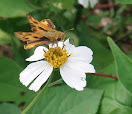Children and their families learned about nature at last year's Back to School- Back to Nature event, plus received a free school supply item. This year's event will be Saturday, August 6 from 9am-noon- free registration at www.campbayou.org .
Education is heading outside in Tampa Bay;
Legislation in Congress would help
ENVIRONMENTAL EDUCATION IS BACK; THIS IS THE TIME OF YEAR TEACHERS USE NATURE AS A TOOL TO INCREASE LEARNING IN VARIOUS DISCIPLINES
(Ruskin)—Local schools and educators increasingly are taking students outside to learn, and seeing the benefits of environmental education in student achievement, test scores, motivation, critical thinking and other skills. But schools are pressed for resources to implement this promising tool, a challenge that would be addressed by legislation introduced this week in Congress: the No Child Left Inside Act.
Camp Bayou Outdoor Learning Center is only one example of a local facility using environmental education as a means to improve learning. Here children, along with their families, teachers and other mentors, can explore the natural world around them and help discover the wonders of nature in their own backyard.
Environmental education uses the outdoors as a tool for hands-on learning. Teachers, for instance, may ask students to collect and assess data on the water quality of a nearby stream. Studies show environmental education can improve student achievement and test scores, especially in math, science and other core subjects, help students think more effectively, provides a real-world context for classroom instruction, and prepares them for the 21st century workforce.
Camp Bayou offers a variety of EE programs for the general public, school groups, summer camps and other youth groups. This fall, we will hold "A Natural Education Weekend", kind of a combination EE conference and family outing. Look for updates at http://anaturaleducation.blogspot.com/ .
Environmental education in various forms started in the 1970s. With the advent of standardized testing, and the passage of the federal No Child Left Behind law in 2001, many schools and educators scaled back environmental education to focus on reading and math--subjects covered by high-stakes standardized tests. In recent years, however, environmental education has enjoyed a dramatic resurgence, perhaps as educators reacted to "teaching to the test" approaches.
But in Tampa Bay and elsewhere educational resources are stretched thin, especially to train teachers in environmental education, and to plan effective programs. A bill in Congress, the No Child Left Inside Act, could help. The bill would provide financial and other assistance to states which are bolstering environmental learning. More than forty states are taking action to urge the development of statewide "environmental literacy" plans, and outdoor plans and strategies. More information
Other signs of a national resurgence in environmental education are abundant:
http://cms.eetap.org/repository/moderncms_documents/comprehensive_ee_article_final_2.24_sm.2.pdf The number of high school students taking the Advanced Placement Environmental Science course jumped 426 percent in the past 10 years compared to an average increase of 97 percent for all AP subject exams over the same period. More information
At least 200 green charters schools have opened across the country in recent years using a research-based curriculum called EIC, or Environment as an Integrating Context for learning. The idea involves using nature and the environment as a teaching tool for everything from math to reading to history. More information
Between 1995 and 2005 all 50 states expanded and strengthened their environmental education programs by 80 percent, measured by the number of key components implemented: dedicated funding, professional development, comprehensive EE plan, etc. More information
Nearly 2,000 schools have joined the national Green School Alliance. Green schools are designed or retrofitted to consume less energy, to reduce waste, and to connect environmental education curriculum to a school's sustainable features. More information
###


No comments:
Post a Comment
Please keep comments on subject- Thanks!